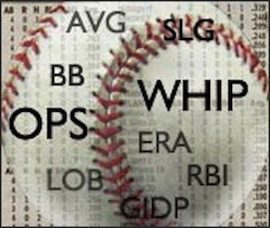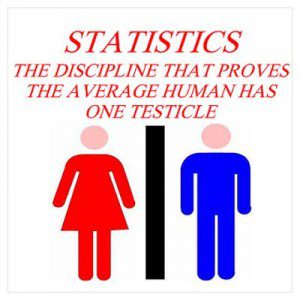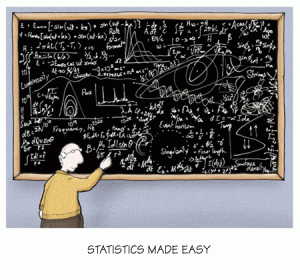

Ever since 1845, this beloved sport has drowned its fans in frippery — or what we longingly call “baseball statistics.” Most of it has been good strumming up feelings of yesteryear and wistfulness, romanticizing each position with sentimentality and equipping homers in each league with enough ammo for one-upmanship in the local watering hole.
Whatever the reason, baseball has pioneered the art of statistics. And just when you thought baseball statistics were for nothing but amusement and card fodder, along comes Billy Bean, his Oh face and Sabermetrics (which should be spelled more accurately SABRmetrics, but it’s not like I’m Bud Selig).
I was reminded of baseball’s affinity for statistics — many of them in the world of the ridiculous — when I read this article from NBC Sports’ Hardball Talk. The headline reads (and I can’t make this stuff up): Baseball Experiences its 138th Worst Season Attendance of All-Time. My initial thought when I read this was “It’s been since 1845. I mean … who thinks of this crap?!”
And that was my muse for the next edition of The Hit List. Sabermetrics ninjas and fantasy connoisseurs, are you ready? What are the most useless baseball statistics ever?
12. VORP — To me, this sounds like two nerds talking baseball statistics in Klingon. It could be an alien bowel movement. I wasn’t sure, so I looked it up. According to Sporting Charts, VORP is “Value Over Replacement Player,” which demonstrates a “less than average hitter and fielder” compared to a real player’s contribution. You see, the “R” in VORP is the invisible man, the imaginary friend, he doesn’t exist. Think of the VORP as a the sabermetric blow-up doll. It creates a good feeling but no one can know about it. And with a name like that, who the hell cares.
11. LIPS — Stay calm, pervs. This is a family show. LIPS means “Late-Inning Pressure Situation.” Consider any point during a game past the 7th inning, and the batter’s team is trailing by three runs, but not four because that’s not pressure — that’s time to go home. And it definitely can’t be two runs because that’s not good for baseball statistics. You need more drama. I guess.

10. UBR — Forget base running. Ignore stealing. Set aside making a home-run trot. This is “Ultimate Base Running.” What the what? Some of the best athletes (sans horse ‘roids) aren’t good enough? We need the American Gladiators to prove some base running should be ultimate? This sabermetric examines the “positive and negative effects of a baserunner’s actions,” which results in an amount of runs a baserunner gained or lost for his team versus the ubiquitous “average” runner doing the same thing. You know, I had a joke about baseball statistics with “ultimate” in it, but I fell asleep after the American Gladiators. Sorry.
9. ERA+ — Yes, earned run average…plus. Plus what? Gatorade? HGH? Prosthethics or bionic legs? You know, because the amount of earned runs, multiplied by nine and divided by innings pitched isn’t enough. Pencil pushers in section 302 need to do crack while scoring a game for “Adjusted ERA,” which is ERA that takes the ballpark and league average into consideration. Two words: “Who cares.” How you pitch is how you pitch. If someone is man enough to turn on a pitch that smashes a leather skidmark on the Green Monster, take into consideration your ball was saved and have a warm cup of shut the hell up.
8. Gold Gloves — And you thought this was going to be a smack on baseball statistics that only discuss sabermetrics. Uh, no. I love this game. And I hate a large sum of the fans. Why? Gold Gloves. Suck players at their positions can get a coveted Gold Glove. Why? Bandwagoner fans or those who are such complete homers they can overlook the errors of said inept “Gold Glovers” (I’m talking to you, Albert Pujols and Adam Jones). See how cyclical that is. If a player wins one, he is pretty much signed on to win two or more by the time retirement hits. Case in point: Mark Teixeira. Dude came up in the Texas Rangers system. His reputation was best defensive first baseman since Mark Grace or Donnie Baseball. He was good…but not that good. Of course, he cropdusted vapor trails on his way to New York, gets paid and becomes meh. He gets votes because people watch ESPN highlights and cameras are always in New York. Mr. McCutchen gets votes because he is badass and no one is hanging out in Pittsburgh.
7. WHIFF — To most baseball statistics aficionados, this is a beloved term by Dan Patrick back when Bristol wasn’t known as “Pimp TV.” To sabermetrics blockheads, the “Whiff Rate” is designed for the pitchers, kinda. The Whiff Rate divides the number of pitches swung at (and inexorably missed to the point a player breaks a hip) by the total number of swings in a given sample. If a pitcher throws 100 pitches at which batters swing, and the batters fail to make contact on 26 of them, the pitcher’s whiff rate is 26 percent. Back in my day, we called those…wait, let me find it…here it is: Strikes. Are we sure politicians didn’t pay Billy Bean to write that forsaken book?
6. Runs — Most baseball statistics are personal, which is why players remember them and cards chronicle them. Statistics make fantasy baseball fun and drafting for need possible. And then you have runs. You have a player who pulls a ball to right field — a frozen rope to the corner. He gets a double, good times. There are some good stats there – a hit, a double. However, if no one behind him in the lineup can touch the ball, he becomes a stat — a LOB runner (left on base). However, let someone behind him turn a curve ball into left and the dude on second legs out a double-bagger and run scored. Good for the team…and the player? Why?! He gets stat padding because of someone else’s work? Outside of a homer, how is the guy on second responsible for scoring a run outside of pulling a hamstring? It’s a “situational baseball statistic” and sucks. Give the team the score and move on.
 5. dERA — It’s been said that statistics are just a bunch of numbers looking for a fight. This sabermetric proves that aphorism, as it pertains to baseball statistics. This is basically a stat based on happenstance, luck or friggin’ Harry Potter hanging out in the all-you-can-eat section. dERA ostensibly highlights what a pitcher’s earned run average would have been, if not for the effects of defense. Because Scott Boras always holds a gun to owners’ heads with “What had happened was…” Child please.
5. dERA — It’s been said that statistics are just a bunch of numbers looking for a fight. This sabermetric proves that aphorism, as it pertains to baseball statistics. This is basically a stat based on happenstance, luck or friggin’ Harry Potter hanging out in the all-you-can-eat section. dERA ostensibly highlights what a pitcher’s earned run average would have been, if not for the effects of defense. Because Scott Boras always holds a gun to owners’ heads with “What had happened was…” Child please.
4. PECOTA — This means (take a deep breath and grab the inhaler) “Player Empirical Comparison and Optimization Test Algorithm.” It’s a mosaic of blurred ink, sweat and nerd drool formula that forecasts a player’s performance in all of the major categories used in typical fantasy baseball games. In addition, PECOTA (also sounds like an illegal substance smuggled across the Rio Grande Valley) forecasts production in advanced sabermetric categories. In other words, most baseball fans could give two craps about this number because the last time PECOTA comes up in a ball game conversation will be the first time.
3. All-Star Appearances — I could just type “See: ‘Gold Gloves'” but why when there is so much more to say (cough…Bud Selig…cough)? As to where those precious pyrite mits are perceived upon skill, this is nothing but a beauty contest. Case in point: A-Rod. People get voted by fans who know bupkus about the great game and just hear the real folk talking fantasy around the water cooler. It is the worst-kept secret in baseball that the All-Star Game means nothing. It’s an exhibition…oh, but it counts. Yeah, and it shouldn’t. If this game counts then votes to get the players there should as well. Another case in point: every team must have a player on the team. Yeah, because the Montreal Expos were the perennial greats on the diamond for years. Moving on.
2. Any Dumbass Stat Line Recited by Tim McCarver — Although this is not a baseball statistic you will find in a fantasy scoresheet or sabermetric disciple handbook, any playoff baseball fan knows what this “statistic” is. Something like “Oh Joe. That’s fascinating. Did you know…” and you know you are in for a stroll down Amnesia Lane that will cause you to trip more times than Stevie Wonder on a brisk jog. Typically, the toes get stubbed and the shins get split with a line like “he has the highest batting average at his position while wearing eye black, one glove, a slightly curved-brim cap and hitting .210 with 29 strikeouts…on Mondays…in June.” Oh, the answer is Carl Yastrzemski. I think.
1. Wins — For years, this is arguably the most debated baseball statistic. Do wins reflect on the team or the pitcher? Should they reflect on the battery, the manager or just the pitcher? Is a win fully the result of the bullpen or the pitcher? Anyone seeing a trend? In Texas, we have an amazing arm on the mound in Yu Darvish. He led the majors in strikeouts with 277. Think he led the majors in “wins”? Uh, no. The team rarely backed him up with hits, runs or defense. He pitched stellar games with almost two perfectos. And to thank him for that effort, the team played like Single-A rejects. The team gets a loss…and so did Yu. That’s not right. He didn’t cause the loss. He didn’t blow a save. No, his team didn’t back him up. Runs have become the least-relevant statistical category in just about any sport. Win-Loss records should be a team statistic not hedged on the pitcher. What does that about Cy Young awards? We have a hit list conspiracy theory section coming next month to celebrate JFK or some such.





